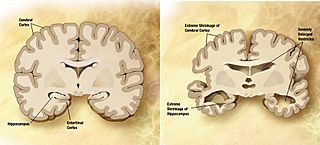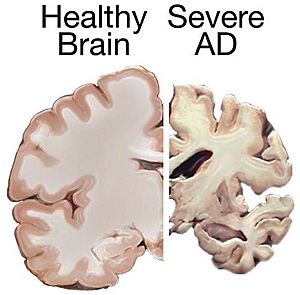Neurodegenerative disease facts for kids
Quick facts for kids Neurodegenerative disease |
|
|---|---|

A normal brain (left) compared to a brain with Alzheimer's disease (right). Alzheimer's is the most common neurodegenerative disease.
|
|
| Classification and external resources | |
| Specialty | Neurology, Psychiatry |
| Patient UK | Neurodegenerative disease |
A neurodegenerative disease is a condition where cells in the brain and nervous system, called neurons, gradually stop working correctly or die. This process is called neurodegeneration. Because neurons are the building blocks of the nervous system, their damage can affect a person's ability to move, speak, think, and remember.
These diseases include Alzheimer's disease, Parkinson's disease, Huntington's disease, and amyotrophic lateral sclerosis (ALS). Scientists have found that many of these diseases share similarities in how they damage cells. This discovery gives hope that finding a treatment for one disease might help in treating others.
Neurodegenerative diseases are a growing concern worldwide. In 2019, about 55 million people had dementia, a condition often caused by these diseases. This number is expected to grow in the coming years.
Contents
Types of Neurodegenerative Diseases
The effects of a neurodegenerative disease depend on which part of the brain is affected. This can lead to problems with movement, memory, or other body functions.
Alzheimer's disease
Alzheimer's disease (AD) is the most common neurodegenerative disease. It mainly affects parts of the brain that control thought, memory, and language. Over time, people with Alzheimer's find it harder to remember things and communicate.
The disease is linked to two main problems in the brain:
- Amyloid plaques: These are sticky clumps of a protein called amyloid beta that build up between neurons, getting in the way of cell communication.
- Neurofibrillary tangles: These are twisted fibers of another protein called tau that build up inside cells. These tangles block the neuron's transport system, harming the cell.
Currently, there is no cure for Alzheimer's, but researchers are working hard to find better ways to diagnose and treat it.
Parkinson's disease
Parkinson's disease (PD) is the second most common neurodegenerative disorder. It primarily affects movement. Symptoms often include tremors (shaking), stiff muscles, and trouble with balance and coordination.
Parkinson's is caused by the death of neurons in a part of the brain called the substantia nigra. These cells produce a chemical called dopamine, which helps control movement. Without enough dopamine, movement becomes difficult.
Inside the affected brain cells, scientists often find clumps of a protein called alpha-synuclein. These clumps are known as Lewy bodies. Researchers believe these protein clumps play a key role in how the disease damages the brain.
Huntington's disease
Huntington's disease (HD) is a rare genetic disorder. This means it is caused by a faulty gene passed down from a parent. The disease causes the breakdown of nerve cells in the brain, leading to problems with movement, thinking, and mood.
A key symptom is chorea, which involves jerky, uncontrolled movements. The disease is caused by a defect in the huntingtin gene (HTT). This defect leads to the creation of a harmful protein that forms clumps inside neurons, especially in areas of the brain that control movement.
Even though the faulty gene is present from birth, symptoms usually don't appear until a person is in their 30s or 40s. There is currently no cure for Huntington's disease.
Multiple sclerosis
Multiple sclerosis (MS) is a disease that affects the central nervous system (the brain and spinal cord). In MS, the body's own immune system mistakenly attacks the protective sheath, called myelin, that covers nerve fibers.
Think of myelin as the plastic insulation around an electrical wire. When it's damaged, nerve signals slow down or get blocked. This can cause a wide range of symptoms, including vision problems, muscle weakness, and trouble with coordination. The exact cause of MS is not known, but scientists believe a combination of genetics and environmental factors may be involved.
Amyotrophic lateral sclerosis
Amyotrophic lateral sclerosis (ALS) is often called Lou Gehrig's disease. It is a rare disorder that attacks the nerve cells responsible for controlling voluntary muscles, like those we use to walk, talk, and eat.
ALS causes these nerve cells, called motor neurons, to gradually break down and die. As the motor neurons are lost, the brain can no longer control the muscles. This leads to muscle weakness that gets worse over time. The cause of most cases of ALS is unknown.
What Causes These Diseases?
Scientists are still learning about the exact causes, but they have identified several risk factors.
Aging
The biggest risk factor for most neurodegenerative diseases is aging. As people get older, their cells can accumulate damage from processes like oxidative stress. This is when harmful molecules, called free radicals, build up and damage parts of the cell, including its DNA. Over a lifetime, this damage can contribute to the start of a neurodegenerative disease.
Infections
Recent studies suggest that certain viral infections may increase a person's risk of developing a neurodegenerative disease later in life. The virus might trigger changes in the body that, over many years, contribute to nerve cell damage. More research is needed to fully understand this link.
What Goes Wrong Inside the Cells?
Many neurodegenerative diseases start with problems deep inside the neurons.
Family Genes
Some neurodegenerative diseases, like Huntington's, are caused by a genetic mutation, which is a change in a person's DNA. DNA is the "instruction manual" for our cells. If there is a mistake in an instruction, it can cause a protein to be made incorrectly.
In some of these genetic diseases, the mistake is a repeated section of DNA code. This creates a faulty protein that can become toxic to the cell, leading to its death.
Problems with Proteins
Many neurodegenerative diseases are considered proteopathies, which means they are caused by problems with proteins. Proteins need to be folded into a specific 3D shape to work correctly, like a key needs the right shape to open a lock.
In these diseases, proteins can misfold, or fold into the wrong shape. These misfolded proteins can't do their job and often become sticky. They clump together, forming aggregates that damage the cell.
- In Alzheimer's disease, the main problem proteins are amyloid beta and tau.
- In Parkinson's disease, the protein is alpha-synuclein.
- In Huntington's disease, it is the huntingtin protein.
The Cell's Cleanup Crew Fails
Our cells have a "cleanup crew" that gets rid of old or damaged proteins. This system, which includes the ubiquitin–proteasome and autophagy pathways, breaks down and recycles waste.
In neurodegenerative diseases, this cleanup system can become overwhelmed or stop working properly. When this happens, misfolded proteins and other cellular "junk" build up, damaging the neuron and eventually causing it to die.
Power Plant Problems
Every cell has tiny "power plants" called mitochondria. They create the energy the cell needs to survive. In many neurodegenerative diseases, the mitochondria become damaged.
When these power plants fail, the cell doesn't have enough energy to function. Damaged mitochondria can also release harmful substances that cause oxidative stress, further damaging the cell.
Damaged Instructions
The cell's DNA contains all the instructions for how the cell should work. This DNA can be damaged by things like oxidative stress. While cells have ways to repair DNA, these repair systems can become less effective with age. If the DNA damage isn't fixed, it can lead to mistakes that contribute to neurodegeneration.
Searching for a Cure
Currently, there are no cures for neurodegenerative diseases. However, there are treatments that can help manage the symptoms and improve a person's quality of life.
Scientists around the world are working hard to understand these diseases better. They use animal models, like mice and fruit flies that have been genetically modified to show signs of a disease, to study how the diseases work and to test new treatments safely.
Researchers are exploring many different ideas, such as:
- Finding ways to stop proteins from misfolding and clumping together.
- Developing drugs that can help the cell's "cleanup crew" work better.
- Using immunotherapy to help the body's immune system clear out the toxic protein clumps.
Although there is still much to learn, every discovery brings us one step closer to finding effective treatments and, one day, a cure.
See also
- Amyloid
- JUNQ and IPOD
- Neurodegeneration with brain iron accumulation
- Prevention of dementia



